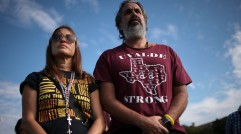Inside the Matamoros Refugee Camp: Where Migrants Fish in Contaminated Rivers
Every year, thousands of migrants escape their home countries in search of life away from bloody cartel wars, violence, and torture. The refugees live in the largest refugee tent city in Matamoros, Mexico-a city just along the border-while they wait for their turn to enter the United States.
The tent city used to be a sprawling soccer field for more than half a year ago. The living condition in the camp is alarming experts who are now calling it a growing humanitarian crisis.
Drastic Living Conditions
In the refugee city, the refugees are forced to live in shabby, makeshift tents that could not protect them from the cold or the heat. The colorful tents and tarps are often held up only by sticks and stones. In some, over ten people share living quarters, making it an ideal breeding ground for viruses and diseases.
The migrants are trapped in dire living conditions with very limited medical services. They do not receive government aid, forcing them to rely on a network of NGOs and volunteers who aim to provide the refugees much-needed health care services.
Their food largely depends on donations from non-profit organizations. The migrants are given their ration that is mostly rice, beans, and coffee packets.
The people do not have access to basic sanitary needs. Safe drinking water is scarce. Refugees line up for half an hour or longer just for a bucket full of water. Some wash their clothes in the Rio Grande, a known breeding ground for E. coli and other bacteria.
Near the wooden toilets, the stench of feces and urine fills the air. Flies buzz around toilet paper and human excrements on the ground. A volunteer uses a shovel to clear the waste that has pooled in front of the only set of toilets in the camp.
Violence
Without protective services, the refugees often find themselves the target of drug cartels. Some are offered to become a member of the gang as a drug trafficker or an assassin. Others are kidnapped and held for ransom.
Mexico has been enveloped by continuous and worsening waves of violence. In 2019, authorities reported an average of 95 murders each day, hitting a record high of nearly 35,000 known murder cases.
The camp residents can only listen and hope they never see a murder happen right outside their tent. They have no protection at night when cartels usually come out, leaving them to fend for themselves.
Diseases and Infections
Doctors and other medical professionals who volunteer at the camp are worried their squalid living conditions might lead to the rapid and devastating spread of the COVID-19 outbreak.
In the camp, the migrants cook their food using wood. Adults and children are often forced to inhale the smoke from the burning wood, leading to a variety of respiratory problems and diseases-problems that make them very vulnerable to the global pandemic.
Children are exposed to numerous factors in the camp: dust, heat, poor living conditions. They are prone to developing parasitic and stomach infections. Some children are living under life-or-death medical conditions. Without proper medical equipment, they could suffer an excruciating death.
Read the latest news from the Americas here:
- 7 Dead in Border Shootout with Los Zetas
- 14-Year-Old California Boy Speaks Out After a Video Shows Apparent Police Brutality
- Guatemala's Maya Villages Spurn US Deportees as Infections Spike
Subscribe to Latin Post!
Sign up for our free newsletter for the Latest coverage!














